Starting in the mid-’60s, the “Low Priced Three”, namely, Ford, Chevrolet and Plymouth, decided to go upscale. Said results included two models familiar to old car nuts: Caprice and LTD. And a third, which only the most with-it Mopar devotees or Brougham aficianados will know of: The Plymouth VIP.

The VIP displaced the Sport Fury as the top big Plymouth in 1966, one year after the LTD and Caprice. And just like its competition, the VIP had the soon-to-be-typical chrome additions, plusher interior, vinyl roof and wood-grained dash and door panels. Although clearly a member of the Fury line, the VIP received its own special brochure apart from the Sport Fury and Furys III, II and I. Initially available only as a four-door hardtop (a hardtop coupe came later), it was marketed as a Plymouth for folks who wanted the finer things in life. Despite gilding the lily of the already well-equipped Sport Fury, the VIP looked as good as any of the other 1966 Mopar full-sizers, thanks to design chief Elwood Engel’s attractive square-rigged styling.

But only about 12,000 were built, compared to over 100,000 LTDs and 181,000 Caprices. And while it was, in your author’s opinion, as attractive and well-appointed as its cross-town rivals, it never broke 20,000 units during its existence from 1966 to 1969. A shame.

But new plans were afoot for the ’67 model year. While the ’66 Plymouths were most attractive in your author’s opinion, their squared-off styling was a little out of style with the advent of GM’s swoopy 1965 Chevrolets.

1967 Plymouths presented smoother, swoopier styling. Especially attractive was the new “Fast Top” roofline, as shown above. This body style was limited to only the Sport Fury and VIP hardtop coupes.

The VIP was back, all new, and with plenty of new Broughamtastic features, particularly inside. Several square feet of woodgrained trim graced the doors and lower instrument panel, along with a filigreed gold medallion that would not look out of place as a belt buckle at Studio 54 just a few years in the future.

The VIP remained available only as a hardtop coupe or four-door hardtop. No pillared sedans and no station wagons were available in the top dog Plymouth. The VIP four door is shown here, and looks particularly fetching in black over red, with the snazzy turbine-style wheel covers. The VIP sedan sold a bit better than the coupe, to the tune of 10,830 units, and started at $3,182. Most of them likely went out the door for a fair bit more than that, with the extensive option list.

It seems strange that Plymouth didn’t offer the VIP as a convertible; that remained the domain of the Sport Fury. Drop-top aficionados had to shell out $3,279 for a Sport Fury, or a slightly cheaper $3118 Fury III variant.

Here we have the non-fastback Fury III hardtop coupe. Although nicely styled, that angular roofline had been around on Plymouths and Dodges since 1963 and looked a little out of date, perhaps. Compare it to, say, a ’67 LTD and you’ll see what I mean. You could also get this body style as a Sport Fury. Formal, yes, but you could always go for the swoopy Fast Top coupe instead.

The cheapest big Plymouth was the Fury I two-door sedan, with virtually no chrome trim outside of bumpers and emblems. Priced at $2,473, it was also seldom seen; a mere 6,647 were produced.
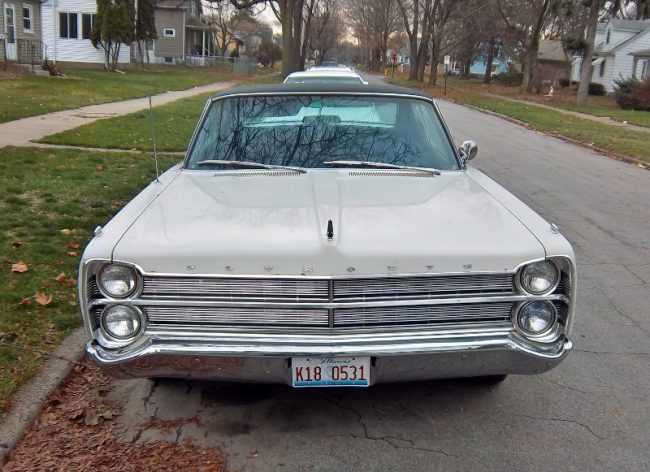
The tried and true Slant Six was standard equipment in almost all Fury I, II and III models, though the Fury II/III wagons and Fury III four-door hardtop and convertible did come with the 318 CID V8. The Plymouth Six was, of course, the bulletproof 225 CID Slant Six that had debuted in the 1960 Valiant compact. With a single-barrel carb and 145 horsepower. The smaller 170 CID Slant Six was not available in full-size Plymouths, being confined to the Valiant line. Probably a good move.
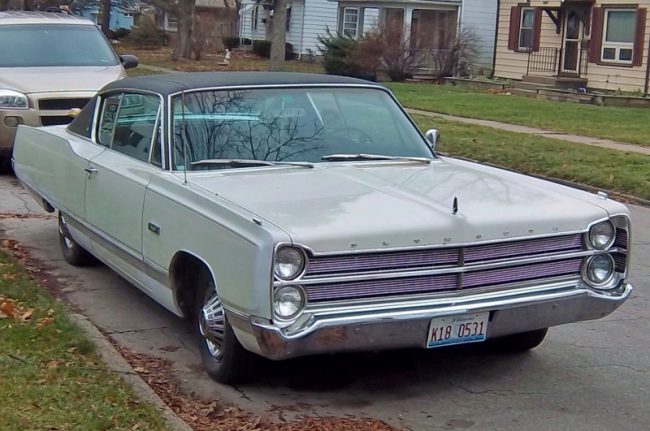
All 1967 full-size Plymouths, regardless of model, got standard carpeting, armrests, heater/defroster, back-up lights, dual brake system, an energy-absorbing steering column and seatbelts.
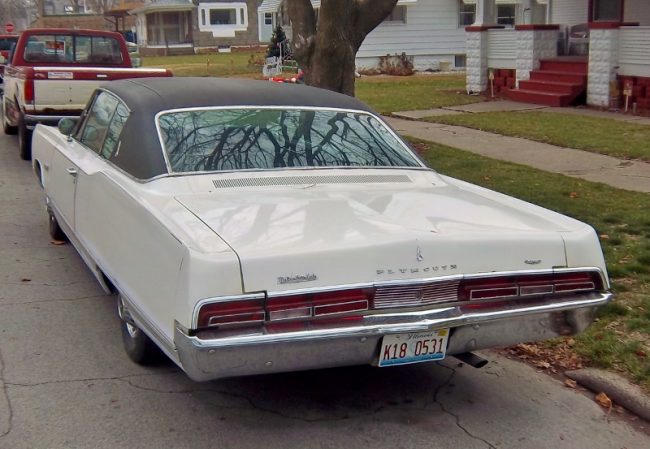
While none of those sounded really exciting to someone ordering a fully-loaded VIP, I imagine it warmed skinflints’ hearts when they were selecting a Fury I.
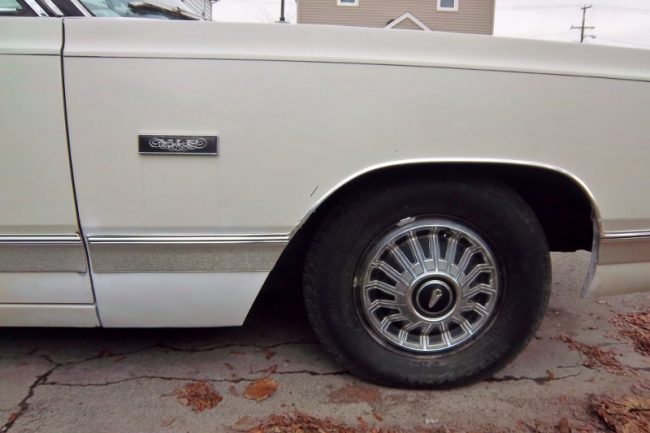
The VIP remained the top of the line, and as such featured prominently in Plymouth advertising, along with the Sport Fury and new-for-’67 Barracuda.
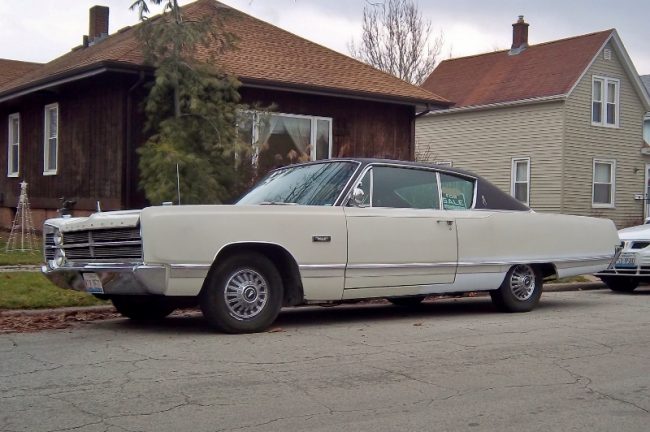
The two-model VIP line featured all Fury III equipment in addition to faux walnut interior trim, Deluxe gold-fleck cloth upholstery with vinyl bolsters, Deluxe wheel covers (those cool turbine wheel covers were optional), 15″ wheels, light group and Flow-Through ventilation.
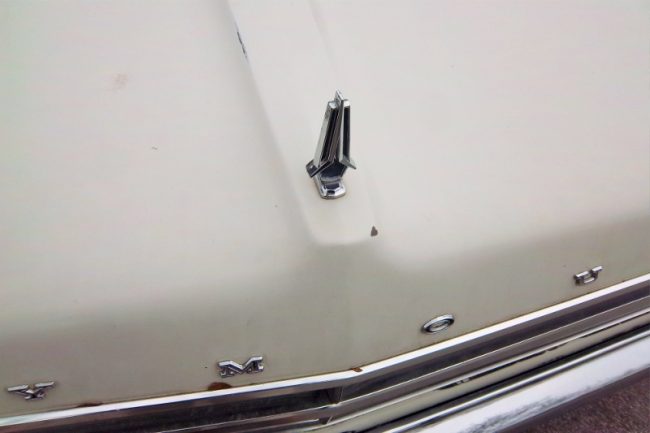
VIPs came standard with a 230-hp 318 V8, breathing through a two-barrel Carter carburetor. If that wasn’t enough motivation for you, a 2BBL, 270-hp 383 ($70), 4BBL, 325-hp 383 ($120) or the top-of-the-heap 4BBL, 375-hp 440 CID V8 ($268) could be installed.
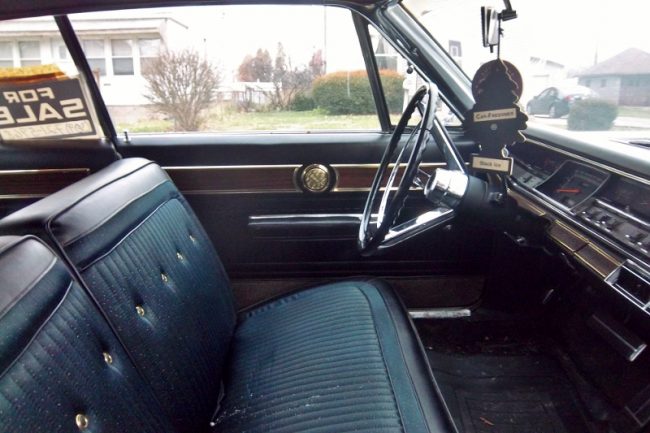
While the VIP was pretty well equipped, with its sparkly upholstery and extra chrome, you could easily tack on an additional $500-$750 in options if you wanted to.

Among the extensive option were air conditioning ($338), automatic speed control ($83) power brakes ($42), power steering ($95) front disc brakes ($70), and a six-way power bench seat ($94). Also available was leather upholstery, available on the VIP alone, for $104.
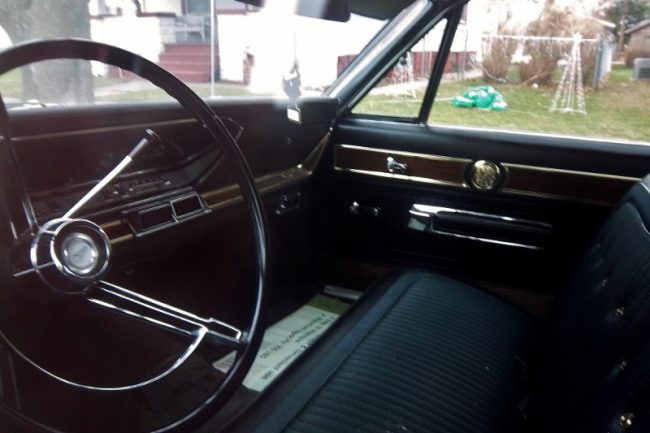
The 3,630-lb. VIP hardtop coupe started at $3,117, $65 cheaper than the VIP four-door hardtop. It was also the less-popular model of the two-car VIP series, with 7,912 produced.

As the 1967 VIP production suggests, the model never really took off, certainly not like the LTD and Caprice. Why is anyone’s guess, but for some, “Sport Fury” may have sounded a lot better than “VIP.” A likely explanation is the Chrysler-Plymouth dealer network itself. After pricing out a loaded VIP, I imagine it was an easy step to just get a Chrysler Newport instead. The Chrysler name certainly had more cachet than Plymouth in the late ’60s.
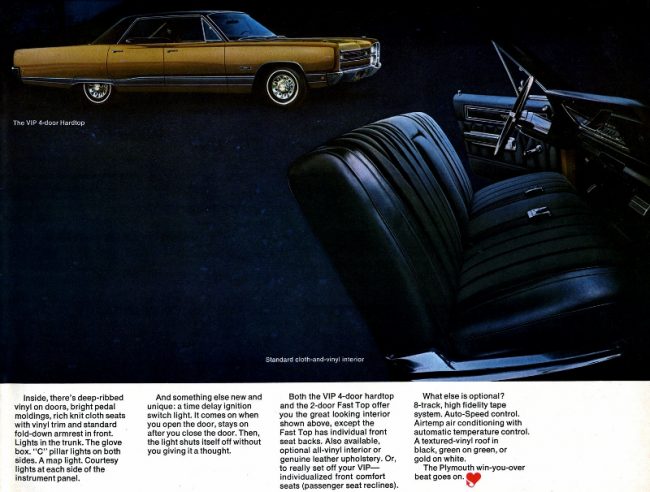
1968 VIPs had the expected ‘new model year’ trim changes and new wheel covers, but at a glance, was very similar to the ’67.

The VIP last appeared for the 1969 model year. In 1970, the Sport Fury once again ruled the Plymouth roost, with a new four-door hardtop model standing in for the ’69 VIP version. The true successor to the VIP in ’70 was, believe it or not, the Sport Fury Brougham. Talk about mixed messages!
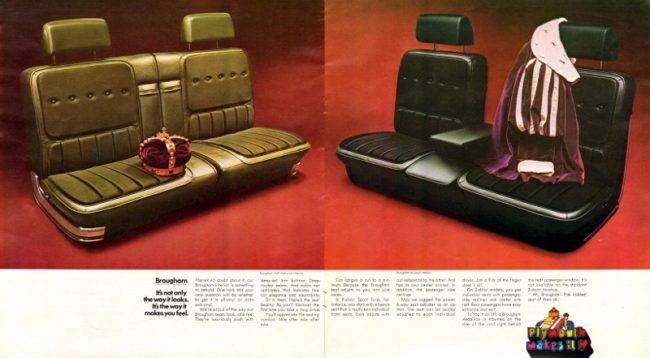
Eventually, the Gran Fury moniker became the top of the line, but even it never reached the sales success of its cross-town-Detroit and Dearborn competitors. Though it did do better than the VIP.

I found our featured VIP in mid-December of 2012, right at the tail-end of a most un-December like spell ofweather, with temperatures in the mid-40s. I was driving along 14th Avenue in Rock Island near Harris Pizza, when I spotted some distinctive ’60s style stacked headlamps on a side street. Whoa. What was that?!
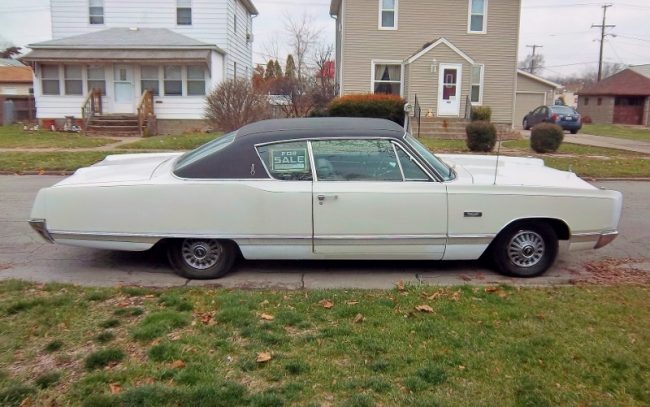
This may well be the only full-size ’67 Plymouth I have ever seen in person. That it was a scarce VIP instead of a more common Sport Fury or Fury III was the icing on the cake. Too bad it wasn’t in a flashier color combo, like those shown in the ’67 brochure. But it seems that white with a black top and interior was VERY popular on cars in the ’60s.

You could tell that it had some rust repair in the past, judging from the lighter patches of white on the rear quarter panels, but it was in quite solid shape. And a rarity in this day and age; VIP sales never broke 20,000 units in any of its years of existence from 1966 to 1969. It was a real thrill to spot this one!
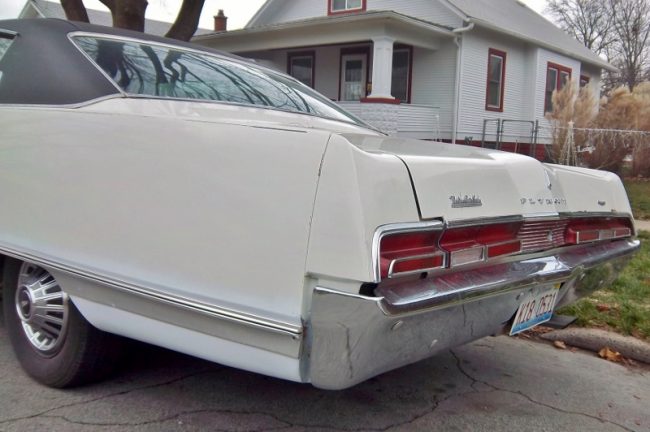




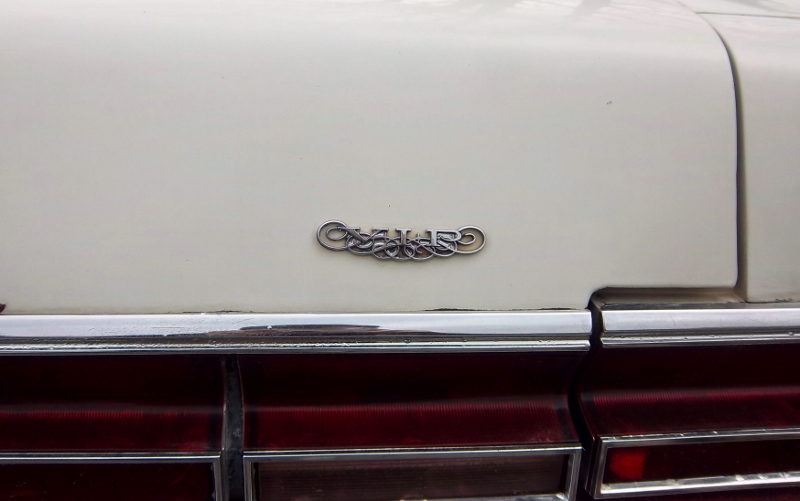





























6 Comments
I was only 11 in 67 but I did notice cars. I don’t think I’ve ever seen one of these before. That side window is pretty unique.
After the above sentence, I did a google image search and one of your photos comes up as the third image. There’s other images of restored cars. Still doesn’t ring a bell.
I did find an image without a vinyl roof.
http://momentcar.com/image-modelYear/12444-plymouth-vip-1967-7.jpg.html#overlayGallery_modelYear_12444_plymouth-vip-1967-7.jpg
I think it’s pretty sharp that way. Probably back in the day, opinions went the other way.
My sister’s husband had one of these back in the day. I was pretty young back then, but I never got the feeling these things were more than or better than any random LTD or Caprice you could point out. Something about these mid 1960’s Plymouths that was so… plain. Even when dolled up as a fancy car, it just seemed like it was pretending. In the same showroom, you could move up to a Chrysler Newport or go across the street and get yourself into a Polara or Monaco for probably very similar money.
Now as then, a great find. I have to believe you’ll probably never find another one, too.
I think this was your first article that I read on CSC
Yeah, it was a relatively early one. Of course, this edition has been revised and expanded from the original version on “the other site.” Ha ha.
was there ever a VIP built with suicide doors
My Dad bought a brand new ’67 VIP in Aug. of ’67, It was gold, 2-dr hrtp, no vinyl top, 383 4-bbl. Boy, did that thing run! I was 16 at the time and learned to drive in it. A few years later, I’d take it out and blow the doors off the new Road Runners, 383 Chargers, Super Bees, Coronets, etc. Can’t believe it ran that good with those little #516 cylinder heads and that really small afb 4 barrel carb. That thing was a BEAR! for such a big, lumbering car. It was also a really nice, tight, quiet, luxurious car. Best car we ever had.